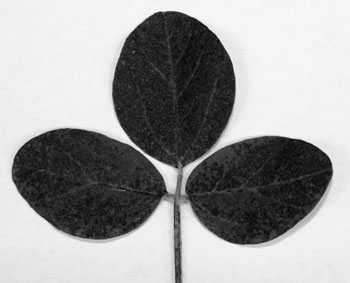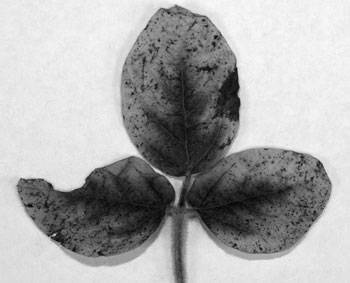Is it spider mite? NO!
Editor’s note: This article is from the archives of the MSU Crop Advisory Team Alerts. Check the label of any pesticide referenced to ensure your use is included.
Earlier this week I received reports of people treating yellow soybeans for spider mite. Although it is possible to have spider mites this early, it isn’t typical. Mites are usually a problem in late July into August during the hot, dry periods. The descriptions of the alleged mite damage (The leaves are a bright shade of yellow, the whole field is yellow, it’s the same for all fields in the area.) didn’t jive with symptoms of early-season mite infestation, which include stippling damage to individual plant cells and often starts on the edges of field. Examining samples from these mite-infested fields revealed that no mites were present, and the symptoms were not that of mite injury. To make matters worse, individuals who treated used pyrethroids, many of which are notorious for flaring (increasing) mite populations by removing beneficial insects. The recommended mite products are OPs, for example dimethoate, Lorsban and generic chlorpyrifos products. Actually my primary recommendation is to find the real cause for the yellowing; it is highly unlikely to be spider mite. Yellow soybean fields are very common at this point. Even if mites were a problem in a few locations, recent rains reduced the likelihood of a spider mite outbreak.
 |
 |
Samples of V2 soybean were sent in to Diagnostic Services with a yellow marginal "flash" and reddish-brown spotting. There were no pathogens or insect pests found associated with the symptoms.This particular field was sprayed a few days prior with glyphosate plus a manganese formulation. While certain manganese formulations can reduce the effectiveness of glyphosate, glyphosate can also have a chelating affect in young soybean leaves. Manganese can be "tied up" resulting in temporary marginal to interveinal yellowing, especially in soils with marginal manganese content and slowly growing soybeans. The reddish-brown spotting on the leaves was attributed to one of the fertilizer-containing products added to the tank. |
|
Good pictures of leaf damage from spider mite and shots of typical field infestations (edge effects) can be found on the Iowa State Entomology Department image page at: http://www.ent.iastate.edu/imagegal/plantpath/soybean/spidermite/
Dr. DiFonzo's work is funded in part by MSU's AgBioResearch.



 Print
Print Email
Email




